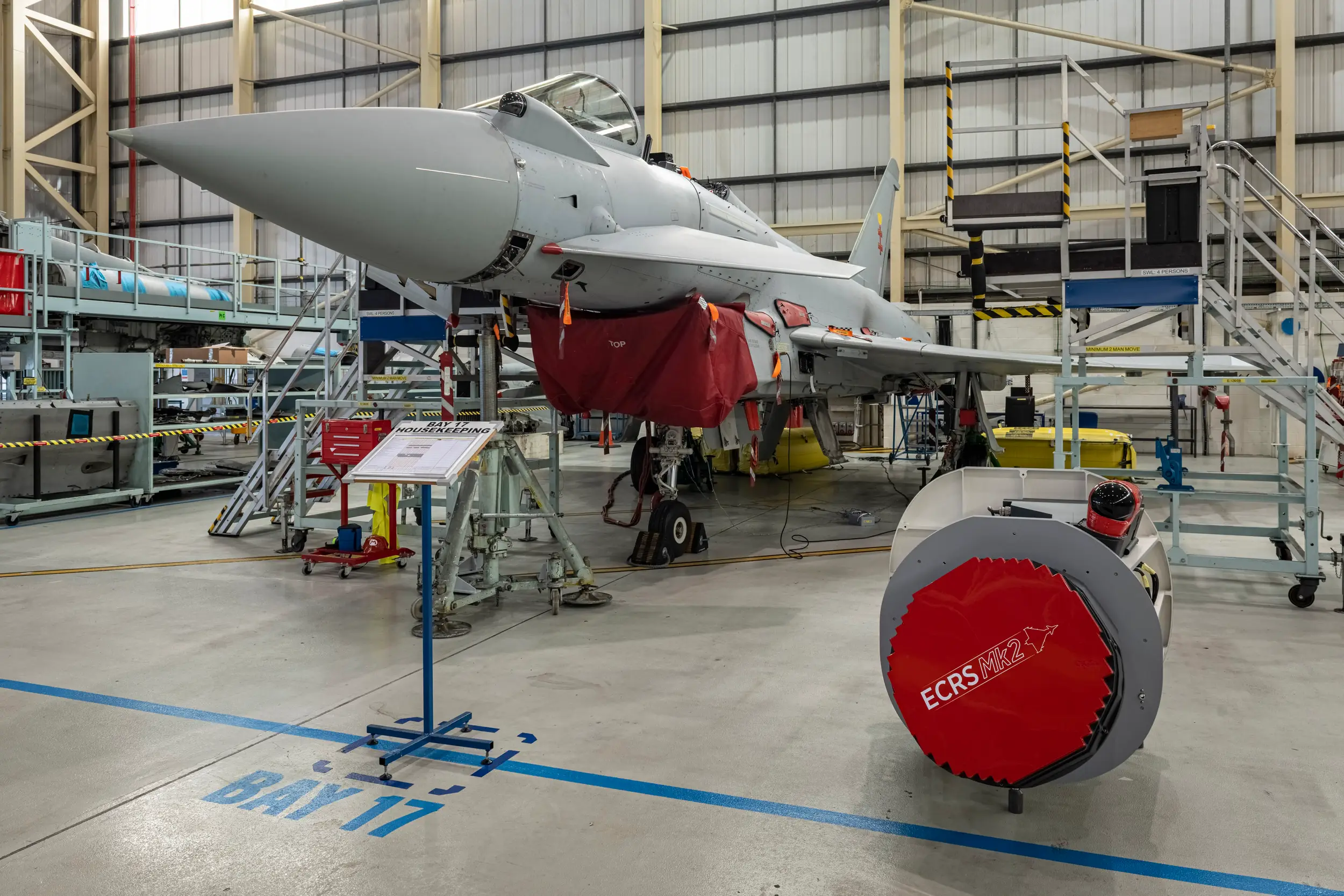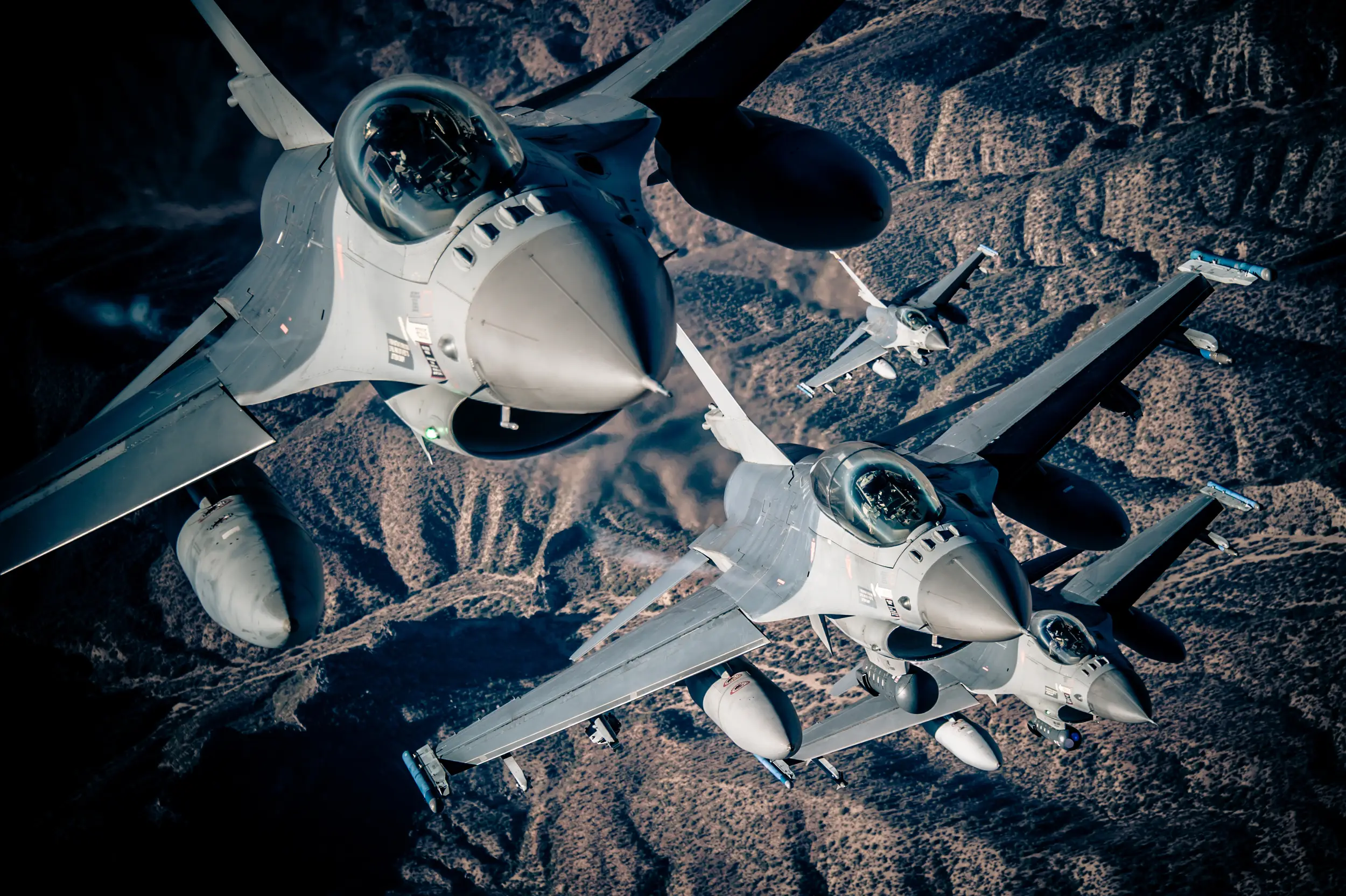
REPORT HOME > Combined effects
June 2023 | technology report | Radar & EW
As air defences become increasingly sophisticated, airborne electronic warfare is evolving in the direction of a networked approach, relying on flexible, redeployable platforms and systems working in concert for maximum effect.
Above: Leonardo works on a variety of EW-related systems, including the BriteCloud digital radio frequency memory expendable active decoy. (Image: Leonardo)
Airborne electronic warfare (EW) systems are vital tools for Western nations in a range of areas, from platform and system protection to suppression/destruction of enemy air defences (SEAD/DEAD). As adversaries inevitably pursue advances in their own capabilities, companies and militaries are continuously looking to the future to keep pace.
Leonardo is one example, working on a variety of EW-related systems and functions, including leading the development of the ECRS Mk 2 Multifunction RF system for the UK’s Eurofighter Typhoon fleet. This combines next-generation wideband AESA radar with high-sensitivity, high-power EW capability, according to Euan Walker, the company’s VP for capability and chief technology officer for EW.
Such systems are developing against the backdrop of a rapidly changing threat environment, Walker said.
DEAD reckoning
Israel’s Rafael meanwhile works across airborne EA systems, including high-power podded solutions that include AESA jammers with gallium nitride (GaN) technology. It has also developed miniature electronic countermeasure (ECM) solutions.
A spokesperson for the company said that data from the Ukraine conflict shows the complexity and demands of SEAD/DEAD missions and the need for advanced EW capabilities.
‘We see a significant increase in demand for airborne electronic attack solutions, specifically dedicated airborne platforms that can provide SEAD/DEAD capability,’ the spokesperson said. ‘In addition, air forces are looking to complement podded high-power jammers with additional stand-in EA capabilities, either delivered by the SEAD/DEAD platform or by other means.’
Missile manufacturers also are exploring ways to adapt their munitions to assist with the SEAD/DEAD task, the spokesperson added, ‘including by integration of dedicated EA payloads’.
Above: Leonardo is leading development of the ECRS Mk2 multifunction RF system for the UK’s Eurofighter Typhoon. (Photo: Leonardo)
Hensoldt is also active across airborne EW, including through its Kalaetron Integral SIGINT package and the Kalaetron Attack system. ‘EW demands together with the development of air defence have evolved from platform self-protection and unit protection to system protection, ie the necessity to counter networked IADS rather than individual air defence sites and to protect a variety of [a military’s] own assets in a wider theatre.’
This means that airborne EW requires a layered approach in terms of the range of the systems, for both reconnaissance and jamming, as well as countermeasure diversification.
Airborne EW packages need to be fully digitalised and to offer broad bandwidths both in the receive and transmit channels to be able to cope with the adaptive behaviour of hostile air defences, the spokesperson added.
Hensoldt highlighted several recent focuses for the company’s Kalaetron Attack system, which is currently preparing for aircraft integration and a second flight test campaign, as well as German Armed Forces exercises. The company has added a new radar warning receiver – the Kalaetron RWR – to its Airborne Missile Protection System (AMPS), among other developments.
The spokesperson also highlighted ‘the networking of different assets (eg distributed sensors, manned and unmanned platforms, flying and ground-based systems) and the increase of data transmission bandwidth in general, not limited to EW’ as key focus points.
Agile opponents
In Raytheon’s view, the threat environment is complex and evolving, leading to demanding requirements in everything from detection range to increased sensitivity. ‘Low probability of intercept (LPI) and software-defined radios operate with frequency agility that is more challenging to track. Further, advancements in integrated air defences complicate aircraft survivability by using a dispersed approach to acquire, track and fire,’ a company spokesperson told Shephard.
They added that military customers are requesting ‘disruptive multispectral mission solutions to assure access, manoeuvrability and effectivity across the electromagnetic spectrum’.
Raytheon works across the airborne EW space, for example providing the USN’s Next Generation Jammer Mid-Band (NGJ-MB) for EA-18G Growlers, as well as a range of technologies for airborne information operations, SIGINT, self-protection and beyond.
Technology must evolve to address the growing threat from AESA beams and highly agile waveforms and frequencies, which harm the effectiveness of RWRs.
‘An increased density of threat coupled with joint and non-combatant emitters further saturates the spectrum and requires additional computational power to resolve,’ the spokesperson added. ‘Legacy systems experience increased interference problems and require improved signal processing.’
James Conroy, VP of navigation, targeting and survivability at Northrop Grumman, said the RF threat environment is now significantly more complex than in the past, with the rise of near-peer adversaries meaning there is ‘a new set of advanced threats that can use the spectrum in a more agile manner’.
He said the company is addressing these changes in multiple ways. The first is the use of open architecture, meaning it can update its systems more quickly to changing threats. For example, aircraft equipped with the APR-39E(V)2 Digital Radar Warning Receiver, ALQ-251 RF countermeasures or ALQ-257 Integrated Viper EW Suite ‘can be updated with new software in a matter of days or even hours in response to a new threat’, said Conroy.
Additionally, he pointed to technological advances such as cognitive systems to address new threats, along with the use of digital twins and mission modelling to virtually create scenarios involving a wide range of adversaries, ‘so we can understand what capabilities would be needed in various missions’.
Another critical focus is collaborative EW, said Conroy, something Northrop Grumman has looked to with the AN/APR-39E(V)2, where it has connected individual EW systems via a network to boost survivability to aircraft across the force.
Digital integration
Patrick Creighton, VP and general manager at L3Harris Electronic Defensive Solutions, highlighted the use of software-defined technology components ‘to enable digital radar threat warning and robust digital countermeasure capabilities in fully integrated, internally mounted systems’. The company has long worked across a range of airborne EW systems, including Viper Shield for the F-16.
Creighton highlighted the threat from uncrewed systems, noting that ‘EW on these platforms has never been more important’. He said the company has developed the Disruptor SRx to support EA, ESM and advanced EW on such aircraft.
Creighton stressed that ‘we no longer have unbridled access to the electromagnetic spectrum – the DoD shares it with a number of commercial interests’. As a result, the EW challenge is heightened, ‘akin to finding a needle in a haystack’.
Above: According to Northrop Grumman, the RF threat environment is now significantly more complex than in the past. (Image: Northrop Grumman)
This drives a need for continued investment in hardware and software, as threats become more advanced and more widely proliferated.
‘To address these challenges, EW systems need to have multiple channels that can see over a broad frequency range, have a wide instantaneous bandwidth, and have advanced algorithms.’
In the rapidly evolving threat environment, one cannot rely on tactics alone to be survivable, added Conroy. ‘It is critical that all platforms, large and small, have EW detection and protection capabilities,’ he said, noting that Northrop Grumman has built its common, ultra-wideband/high-power architecture to be scalable to meet size weight and power requirements and protect against emerging threats.
Rafael said the main technological focus for airborne EW will be the introduction of AI algorithms into operational systems to better cope with the continuously evolving EM spectrum. ‘The step from research and development to operational use is much more challenging for AI algorithms than for any other previous technology,’ the spokesperson added.
Walker said AI/ML will ‘increasingly underpin future EW systems to provide adaptability and agility, recognising the huge explosion of data being generated, exploited and shared by sensors within and across platforms.’
Additionally, he said ‘deep integration’ is the future direction of travel for airborne EW, something that has been pursued through the Integrated Sensing and Non-Kinetic Effects and Integrated Communications System (ISANKE/ICS), which Leonardo UK is leading for the UK as part of the Global Combat Air Programme (GCAP).
‘With ISANKE & ICS, the GCAP core platform will not have traditional individual sensors such as “radar” or “EW sensors” but integrated capabilities where the combined effect acts as a force multiplier, more than the sum of its parts.’
Future EW systems will increasingly exploit software-defined capabilities, he added, allowing for adaptable and agile functions.
‘The sheer complexity of the future electromagnetic battlespace, and the flexibility and configurability of future systems, drives a need to increase the use of synthetics to fully develop and assure EW sensor and effector capability envelopes,’ Walker concluded.


